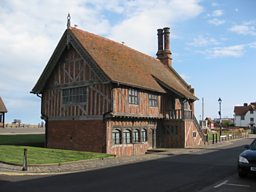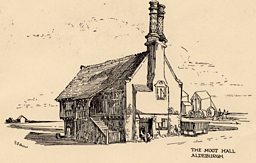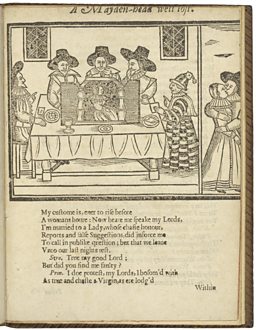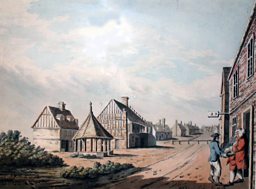Aldeburgh’s Moot Hall – where Shakespeare's troupe performed
Aldeburgh was most definitely on the map when it came to performances of Shakespeare in and around the Bard’s own lifetime.
It was part of the East of England ‘circuit’ of locations visited by various touring groups, as they followed a coastal route which also took in places such as Ipswich, Dunwich and Norwich.
-
![]()
Much ado near me
Hear more Shakespeare stories on BBC Radio Suffolk
-
![]()
Shakespeare Festival 2016
The BBC celebrates the genius of the bard

James Stokes, Suffolk editor from the Records of Early English Drama (REED), writes:
In 1635 they received 17 shillings for a performance staged after midsummer. This payment in 1635 was a historical milestone.
“Although there’s no record that Shakespeare’s own troupe The King’s Men visited Aldeburgh while he was with the company, long after Shakespeare’s death, his company visited twice - in 1634 and again in 1635.
“In 1634, the town bailiff ordered that they be paid for a performance mounted sometime after midsummer.
In 1635 they received 17 shillings for a performance staged after midsummer. This payment was a historical milestone. It would be the last one given to a troupe of travelling professional players in Aldeburgh during the Early Modern period.”
Although Shakespeare’s first troupe of players – known as the Lord Chamberlain’s Men and then the King’s Players – performed largely at court in London or in the capital’s theatres, the Queen’s Men were Elizabeth’s designated touring troupe and it was they who most definitely visited Aldeburgh.
The probable performance venue was Aldeburgh Moot Hall (a meeting or assembly building, traditionally to decide local issues). Between 1583 and 1593, the Queen’s Men performed in Aldeburgh almost every year. Sadly there are no surviving records which link Shakespeare himself with visiting the town.
The Queen’s Men almost always arrived in Aldeburgh between May and July, but on one occasion they visited in December. Sometimes they received 20 shillings from the town, sometimes 40 shillings, suggesting either that the constitution of the troupe varied, or that the size and scale of the performance did.
During the trip to Aldeburgh in 1591, the Queen’s Men buried one of its members who had died - a youth named Humphrey Swain, who was servant to a member of the troupe. The cause of his death is unknowable from the records.

Just who were the Queen’s Men?
This group formed around the same time that Shakespeare’s group of actors was officially given the name of ‘The King’s Men’, by royal patent from the new King James.
Among the members of this Queen’s Men were Christopher Beeston, its manager, and the actor and dramatist Thomas Heywood, who wrote many of the company’s plays including The Rape of Lucrece and The Golden Age.


Shakespeare on Tour
From the moment they were written through to the present day, Shakespeare’s plays have continued to enthral and inspire audiences. They’ve been performed in venues big and small – including inns, private houses and emerging provincial theatres.

BBC English Regions is building a digital picture which tracks some of the many iconic moments across the country as we follow the ‘explosion’ in the performance of The Bard’s plays, from his own lifetime to recent times.
Drawing on fascinating new research from Records of Early English Drama (REED), plus the British Library's extensive collection of playbills, as well as expertise from De Montfort University and the Arts and Humanities Research Council, Shakespeare on Tour is a unique timeline of iconic moments of those performances, starting with his own troupe of actors, to highlights from more recent times. Listen out for stories on Shakespeare’s legacy on your BBC Local Radio station from Monday 21 March, 2016.
You never know - you might find evidence of Shakespeare’s footsteps close to home…
Craig Henderson, BBC English Regions
Aldeburgh's blind musicians
Aldeburgh’s town records, as well as revealing how the residents lived in fear of various potential threats also show a remarkable sense of charity to a young blind boy called Harry.
Many local officials found it both charitable and practical to support blind youngsters by teaching them to sing or play
He was supported by charitable payments from the town corporation which stretched over 20 years. It appeared the boy had a real talent as a musician and was awarded hand-outs for musical instruments and performances, as well as clothing.
Indeed civic records throughout England include payments to blind musicians such as harpers or fiddlers. Many local officials found it both charitable and practical to support blind youngsters by teaching them to sing or play.
Visiting troupes of actors such as Shakespeare’s would have encountered blind musicians like Harry performing on street corners or in ale houses and inns. Shakespeare definitely knew of them. For in Love’s Labour’s Lost the chastened Berowne swears to Rosaline that he will never more “…woo in rhyme, like a blind harper’s song”. (V.ii.405)
-
![]()
Shakespeare Lives
The nation’s greatest performing arts institutions mark 400 years since the Bard's death
Related Links
Shakespeare on Tour: Around Suffolk
-
![]()
Ipswich: a magnet for Shakespeare's players
Why East Anglia became the favored playing circuit among major troupes
-
![]()
Dunwich - a destination point for Shakespeare's players
What drew Shakespeare and his players to Dunwich?
-
![]()
Fledgeling Ipswich Theatre shows a passion for Shakespeare
Touring players from Norwich visit Ipswich
-
![]()
Shakespeare's Men perform in Sudbury
Before the Puritans seem to take hold
Shakespeare on Tour: Around the country
-
![]()
The King's Men generously welcomed to Cumbria
King James I also spends time in Cumbria
-
![]()
Shakespeare… by gaslight!
An 1819 playbill invites people to enjoy the newly-installed gas lighting in the theatre
-
![]()
Shakespeare's acting company come to Barnstaple
Was Shakespeare among them?
-
![]()
Garrick’s festival entertains a Birmingham audience
Famous Jubilee Shakespeare celebration comes to the second city











